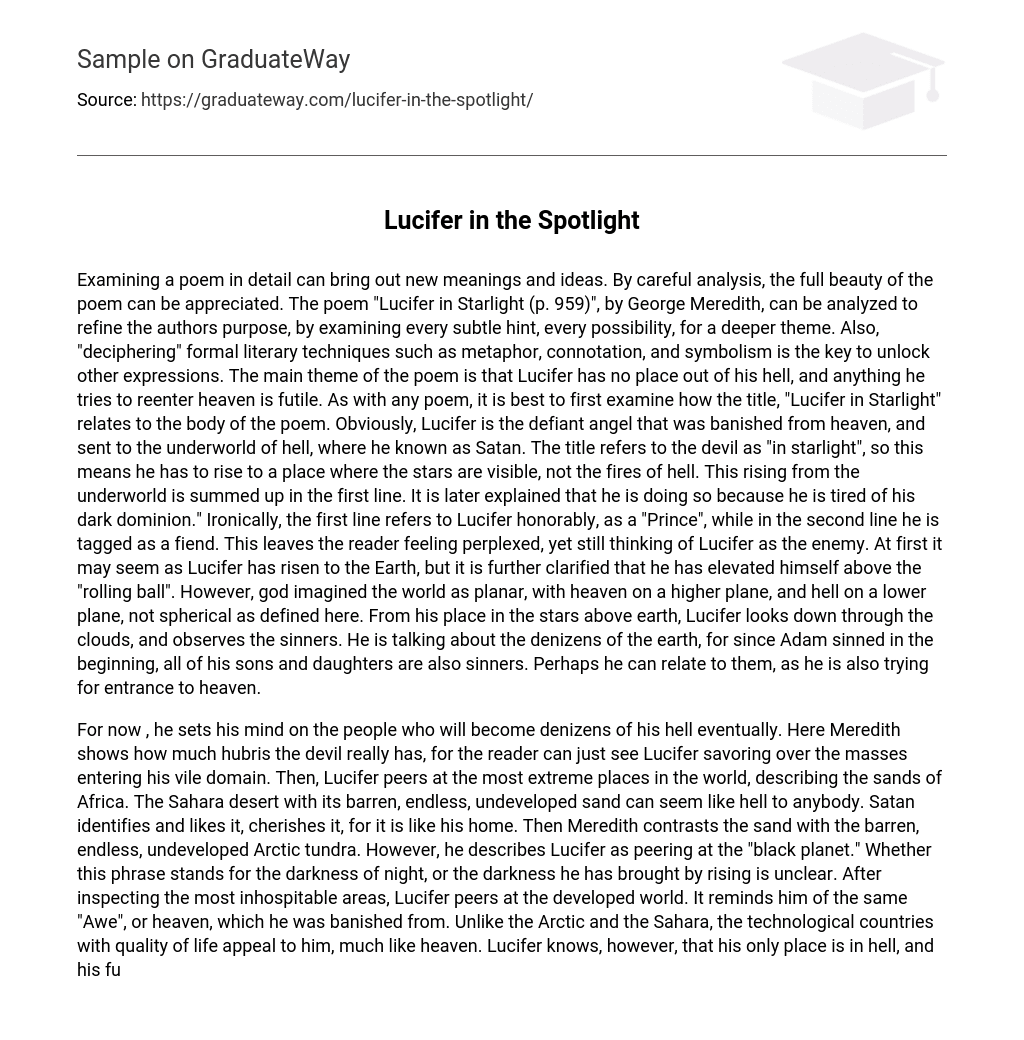When a poem is closely examined, it can reveal new meanings and ideas, and its true beauty can be fully appreciated. George Meredith’s poem “Lucifer in Starlight (p. 959)” can be analyzed extensively to better understand the author’s purpose and uncover deeper themes by considering every subtle hint and possibility.
The main idea of the text is that understanding literary techniques such as metaphor, connotation, and symbolism is crucial for interpreting different expressions. The poem’s central theme revolves around the idea that Lucifer has no place outside of his hell and that any attempt he makes to return to heaven is pointless. It is essential to analyze how the title, “Lucifer in Starlight,” relates to the content of the poem. Lucifer represents the disobedient angel who was expelled from heaven and sent to hell, where he is known as Satan. The title suggests that the devil is “in starlight,” indicating that he must ascend to a realm where stars become visible instead of the fires of hell.
This passage discusses the emergence of Lucifer from the underworld. It begins by stating that this event is summarized in the first line. The reason for his emergence is later explained as him growing tired of his dark dominion. Interestingly, the first line refers to him as a respectable “Prince,” while the second line labels him as a villainous fiend. This contradiction leaves readers puzzled, but still perceiving Lucifer as their adversary. Initially, it may appear that Lucifer has ascended to Earth, but it is clarified that he has risen above the “rolling ball,” implying the spherical nature of the world. It should be noted that this contradicts the traditional conception of heaven and hell as different planes, with God visualizing Earth as planar. From his position among the stars, Lucifer gazes down through the clouds and observes the sinners.
He is discussing the inhabitants of the earth, as all of Adam’s children are sinners since his original sin. Maybe he can understand them because he is also striving for admittance to heaven. At the moment, he focuses on the individuals who will eventually become residents of his hell. In this passage, Meredith reveals the immense arrogance of the devil, as one can easily imagine Lucifer relishing in the multitude entering his wicked realm. Additionally, Lucifer examines the harshest locations on earth, specifically describing the African deserts.
The Sahara desert, with its vast expanse of barren and undeveloped sand, can be perceived as a hellish place. Satan is drawn to it and finds a sense of comfort in its similarity to his own domain. By contrast, Meredith highlights the desolation of the Arctic tundra, which also consists of endless and undeveloped land. However, he portrays Lucifer as gazing upon the “black planet.” It remains unclear whether this phrase refers to the darkness of night or the darkness brought about by his presence.
Upon examining the most inhospitable regions, Lucifer now casts his eyes upon the developed world. It evokes in him the same sense of “Awe” or heaven that he was once expelled from. Unlike the Arctic and the Sahara, the technologically advanced nations with their high standard of living have an appeal to him, reminiscent of heaven. Nevertheless, Lucifer is aware that his only rightful abode is in hell, and his endeavors to gain a foothold in heaven are futile and likely to end in failure. Ascending even higher, Lucifer raises his gaze to heaven.
His ultimate goal, which is almost within reach, is suddenly blocked by the force of god just as he is about to proceed. He then retreats back to his own world. According to Meredith, this blocking is referred to as the “unalterable law,” which indicates that everything has its designated place in this world, aligning with traditional beliefs. This law also proves that this is not a “poem of initiation” as Lucifer has attempted to defy it multiple times without gaining any knowledge. The poem’s structure is also peculiarly irregular. While most of it follows a pattern of rhymed iambic pentameter, whenever Lucifer is directly involved, the lines are indented and contain twelve syllables each.
Maybe this is due to Meredith’s intention to illustrate Lucifer’s control. The poem adheres to the sonnet structure of fourteen lines, yet it lacks quatrains. Instead, there are sections consisting of 5, 5, 2 lines, followed by a final couplet. Through this deviation from the norm, Meredith crafts a remarkable masterpiece.
In this remarkable piece, Meredith demonstrates the devil’s powerlessness in the face of God while emphasizing his sole dwelling, hell. Through the use of irony and his unique style and tone, Meredith skillfully depicts this ordeal with authenticity. The caliber of Meredith’s writing renders this poem deserving of more than just a spot in an English book.





